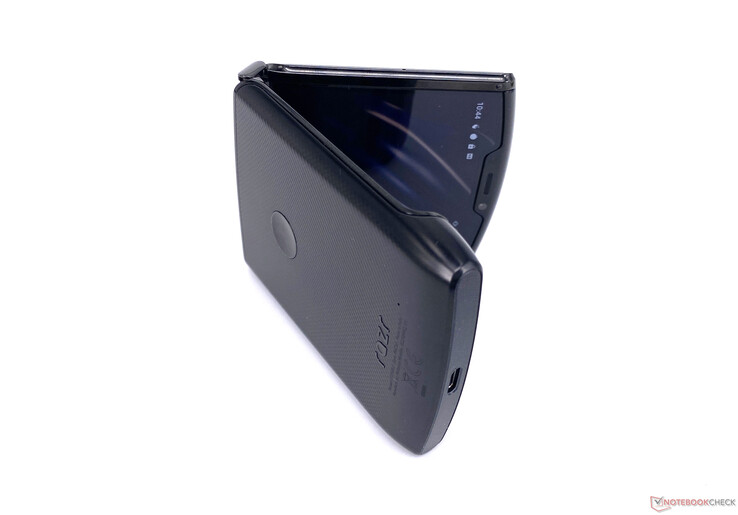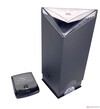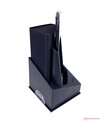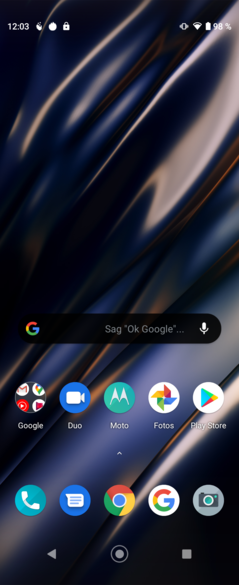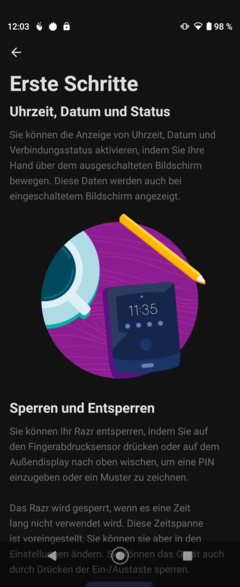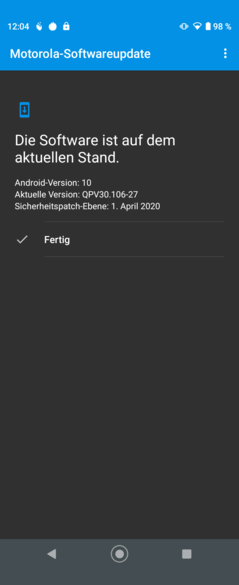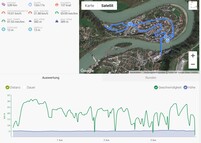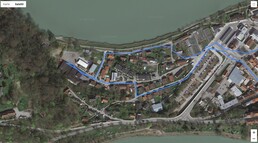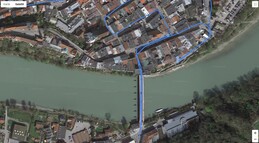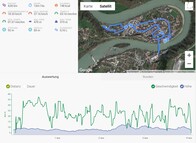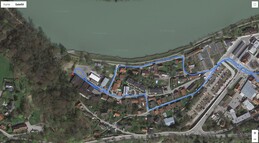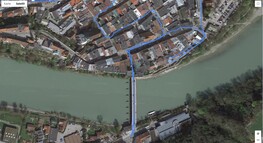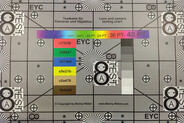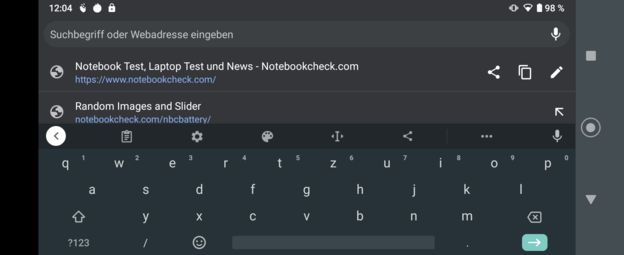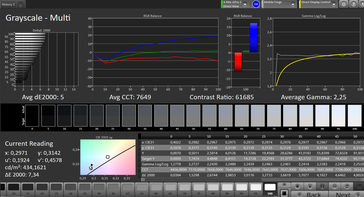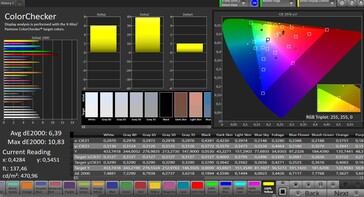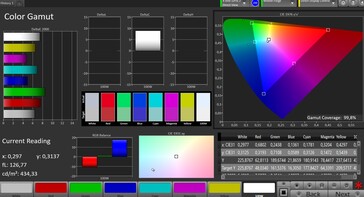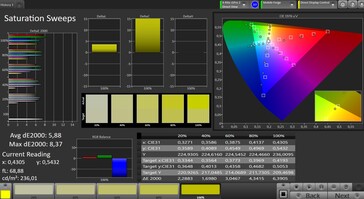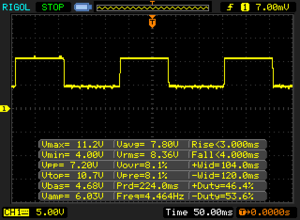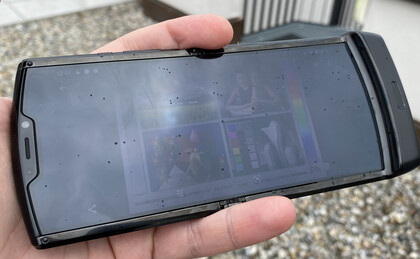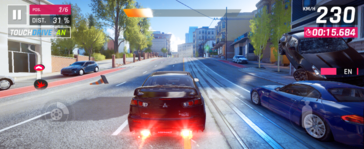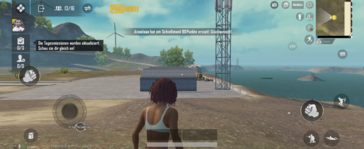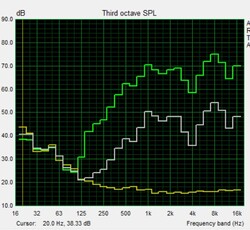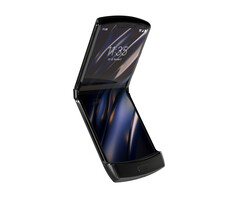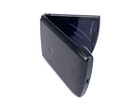Motorola Razr 2019 Smartphone Review – Foldable Phone with Retro Charm
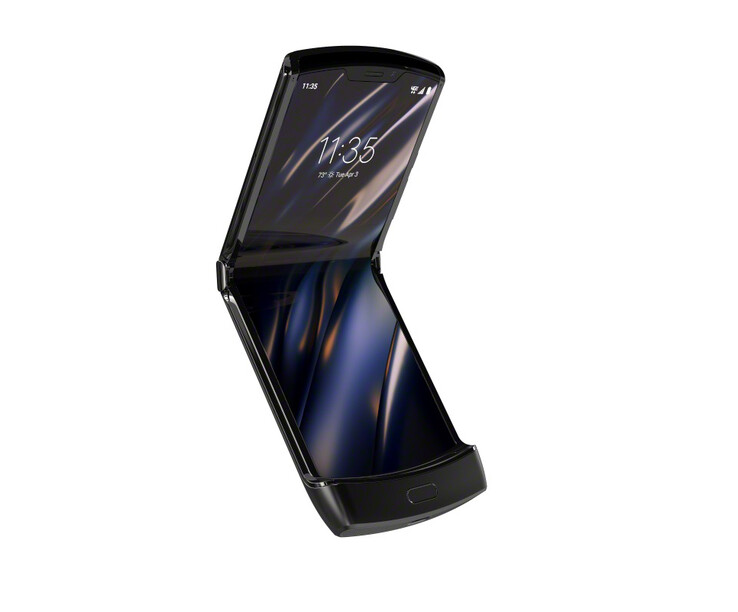
Those who didn't have it in the 2000s at least knew someone who had it: The Motorola Razr, a legendary flip phone with an extremely slim construction and a sleek design that turned it into a classic. Now, Motorola is trying to build upon this well-established name to enter the market of foldable phones and more specifically phones with a foldable display. Thus, we are now testing the Motorola Razr 2019, which is indeed reminiscent of the manufacturer's ancestral Razr phones.
The smartphone costs almost 1500 Euros ($1500 in the US) and it comes with a few peculiarities: It can only be used with an eSIM, the specs are mid-range level, there is only a single-camera, and the battery is relatively small. Does the foldable display make up for the expensive price and lean specifications? Let's find out.
Competing Devices
Rating | Date | Model | Weight | Drive | Size | Resolution | Price |
|---|---|---|---|---|---|---|---|
| 76.1 % v7 (old) | 06 / 2020 | Motorola Razr 2019 SD 710, Adreno 616 | 205 g | 128 GB UFS 2.0 Flash | 6.20" | 2142x876 | |
| 86.4 % v7 (old) | 10 / 2019 | Samsung Galaxy Fold SD 855, Adreno 640 | 276 g | 512 GB UFS 3.0 Flash | 7.30" | 2152x1536 | |
| 82.5 % v7 (old) | 03 / 2020 | Samsung Galaxy Z Flip SD 855+, Adreno 640 | 183 g | 256 GB UFS 3.0 Flash | 6.70" | 2636x1080 | |
| 82.6 % v7 (old) | 04 / 2020 | Huawei Mate Xs Kirin 990 5G, Mali-G76 MP16 | 300 g | 512 GB UFS 3.0 Flash | 8.00" | 2480x2200 | |
| 84.6 % v7 (old) | 11 / 2019 | LG G8X ThinQ SD 855, Adreno 640 | 192 g | 128 GB UFS 2.1 Flash | 6.40" | 2340x1080 |
Case – Foldable Phone with a Secondary Display
Motorola has put a lot of effort into creating a good unboxing experience: The Motorola Razr 2019 is delivered in a plastic prism with a glass top. On the inside, a stand holds the smartphone in an upright position.
While Motorola tries to create a high-quality impression with the box, the Razr phone itself mainly consists of plastic, which does not result in a particularly premium look and feel. In Central Europe, the only available color variant is black, whereas the international version also comes in gold. When folded, the smartphone itself measures 72 x 94 x 14 mm (~2.8 x 3.7 x 0.55 in) and although the 14-mm (~0.55 in) hump on the bottom of the display, which appears to contain the battery, retains its original position when the phone is opened, Motorola has not included it in the official dimensions.
Since the Motorola Razr 2019 is opened vertically, its display is relatively narrow and long, as opposed to the tablet form factor of the Samsung Galaxy Fold. The hinge consists of two visible, interlocking cogs for a mechanism that can be observed when folding the phone. Unfortunately, folding the smartphone is not as easy as it should be and on top of that, there are uncomfortable crunching noises, which do not inspire confidence in the longevity of the foldable display.
There are already reports from users and stress tests on the internet that put the long-term durability of the display into question. However, Motorola disputes these claims. While we are unable to provide long-term results, since we will have to return our test device, there were no issues during our test period.
Although it weighs 205 g (~7.23 oz) and thus slightly more than the Samsung Galaxy Z Flip, the smartphone is generally easy to handle.
Features – Insufficient for the Price
Compromises will have to be made when it comes to the features. 128 GB of internal storage with no option for storage expansion via microSD for 1500 Euros ($1500) is disappointing. In fact, there are no card slots at all and even the SIM compatibility is limited to eSIM only, which is why everyone with a physical SIM will have to obtain an eSIM from their carrier.
At least, there is a USB 3.1 Gen 1 Type-C port and although it also serves as the only audio output, Motorola has included a 3.5-mm adapter. With Bluetooth 5.0 and NFC, the wireless interfaces are fairly up-to-date.
Software – No Ads
As per usual, the Motorola phone ships with a relatively pure Android 10, but there are already two updates available after first starting the device. The security patches on our test device date back to April 2020 and while this is barely acceptable, a smartphone this expensive demands more up-to-date security in the very near future.
There is no bloatware and instead, only Motorola's own applications have been preinstalled to explain certain features of the Razr 2019 or to provide access to additional settings.
Communication and GPS – Wi-Fi 5 with Appropriate Speeds
The LTE modem reaches up to 800 Mb/s when downloading files and while it supports a lot of frequencies, it is probably still insufficient for globetrotters.
The Wi-Fi module only supports Wi-Fi 5 speeds, which is standard for mid-range smartphones and we would have liked to see at least Wi-Fi 6 support on a smartphone with an MSRP of 1499 Euros ($1499). While the transfer speeds match our expectations for Wi-Fi 5 devices, occasional dips are noticeable.
| Networking | |
| iperf3 transmit AX12 | |
| Motorola Razr 2019 | |
| Samsung Galaxy Fold | |
| Huawei Mate Xs | |
| Samsung Galaxy Z Flip | |
| LG G8X ThinQ | |
| iperf3 receive AX12 | |
| Huawei Mate Xs | |
| Samsung Galaxy Fold | |
| LG G8X ThinQ | |
| Samsung Galaxy Z Flip | |
| Motorola Razr 2019 | |
Outdoors, our test device quickly locates us with an accuracy of within 3 meters (~10 ft). To achieve this, it can connect to various satellite networks.
Since the locating capabilities of the Motorola Razr are very solid apart from a few minor deviations and inaccuracies, we recommend it to users who are looking for a smartphone with relatively precise geolocation.
Telephony and Call Quality – Noticeable Ambient Noise
The Razr uses Google's default Android telephony app. The SoC supports both VoLTE and Wi-Fi calling.
The call quality is mediocre: There is noticeable static and ambient noise on both ends of the line. Similarly, the voice of our conversational partner is not very distinct and our voice does not come across as rich and natural when using the speakerphone and the hands-free microphone.
Cameras – Razr with Few Lenses
A lot has changed for the camera of the new Motorola Razr: The main camera consists of just one lens on the flip top that doubles as a selfie camera when the phone is closed. However, there is still a dedicated selfie camera on the inside.
The main camera has a resolution of 16 megapixels and although it produces pictures with rich colors, it appears to have difficulty focusing objects. In low-light conditions with a high dynamic range, details remain discernible even in darker areas, although their sharpness suffers as well. The camera quality would be more appropriate for a smartphone that costs 1000 Euros less.
While it is possible to record 4K video, the recordings are limited to 30 FPS. Although the exposure is good, adjustments to changing conditions occur in noticeable steps. The quality of the results is decent overall.
The dedicated front camera at the top of the display has a resolution of just 5 megapixels and there is once again room for improvement in terms of the sharpness.
The main camera has to prove itself once more in our lab, which shows the color representation to be fairly accurate in good lighting and even in poor lighting, part of the image can still be made out. However, the picture of our test chart lacks sharpness and colors appear relatively pale.
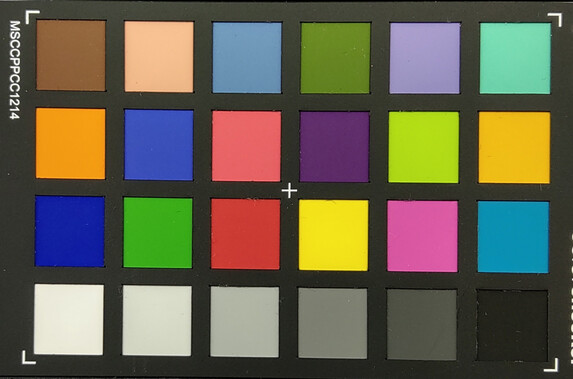
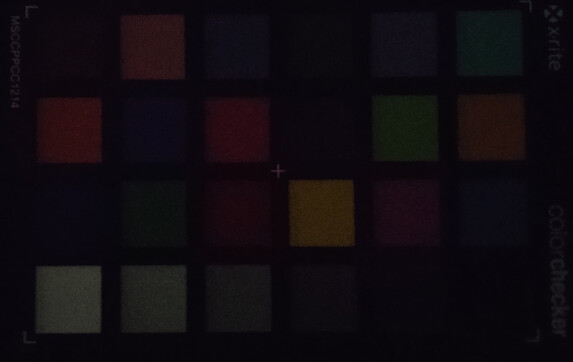
Accessories and Warranty – Sleek Extras
The accessories can be stored in an elegant triangular box. Motorola has included a quick charger, a nice-looking, braided USB Type-C cable and a USB Type-C headset with a matching design. There is also a USB Type-C to 3.5 mm jack adapter in the box, which is good to see. Furthermore, the stand which the Motorola Razr ships in is not just visually appealing, but it is also supposed to enhance the audio experience of the speakers. Does it work and if so, how well? More on that in the speaker's chapter.
Motorola offers its customers a 24-month warranty.
Input Devices & Handling – Stand-alone Fingerprint Sensor
Using the touchscreen is a pleasant experience, although the plastic surface does not exhibit the same premium feel as glass and there is some unevenness around the hinge area. Thankfully, this barely has an effect during use. The outer display is also precise and a swiping to the right activates the main camera for selfies. Additionally, most important settings can be adjusted directly from the outer display and it of course also displays new messages.
Since the buttons on the right are fairly small, the ribbed texture of the standby button comes in handy and it allows users to more easily identify it by touch, whereas the volume buttons are harder to find.
The fingerprint sensor is located below the display on the hump. While it unlocks the smartphone quickly and precisely, its position is not ideal, since you may need to change your grip to reach it.
Display – Dim Screen
Due to its folding mechanism, the Motorola Razr offers two displays: The main display has an unusual resolution of 2142x876 pixels, which is not particularly high. Thus, the width slightly misses the Full HD mark and while the aspect ratio is suitable for cinemascope content in the 21:9 format, there are fairly wide black bars on the sides during the playback of normal 16:9 content. The display type is P-OLED.
With an average of 428 cd/m², the maximum brightness is very low compared to other flip phones and generally lackluster.
The secondary display on the front is also an OLED display and offers a resolution of 800x600 pixels and support for touch inputs to control basic smartphone settings.
| |||||||||||||||||||||||||
Brightness Distribution: 89 %
Center on Battery: 428 cd/m²
Contrast: ∞:1 (Black: 0 cd/m²)
ΔE ColorChecker Calman: 6.39 | ∀{0.5-29.43 Ø4.78}
ΔE Greyscale Calman: 5 | ∀{0.09-98 Ø5}
99.8% sRGB (Calman 2D)
Gamma: 2.25
CCT: 7649 K
| Motorola Razr 2019 P-OLED, 2142x876, 6.2" | Samsung Galaxy Fold Infinity Flex-Display (Dynamic AMOLED, 7,3") und Super AMOLED (4,6"), 2152x1536, 7.3" | Samsung Galaxy Z Flip Dynamic AMOLED, 2636x1080, 6.7" | Huawei Mate Xs OLED, 2480x2200, 8" | LG G8X ThinQ OLED, 2340x1080, 6.4" | |
|---|---|---|---|---|---|
| Screen | 43% | 48% | 26% | 11% | |
| Brightness middle (cd/m²) | 428 | 531 24% | 705 65% | 417 -3% | 570 33% |
| Brightness (cd/m²) | 428 | 532 24% | 709 66% | 418 -2% | 581 36% |
| Brightness Distribution (%) | 89 | 97 9% | 97 9% | 99 11% | 90 1% |
| Black Level * (cd/m²) | |||||
| Colorchecker dE 2000 * | 6.39 | 2.3 64% | 3.1 51% | 2.6 59% | 6.27 2% |
| Colorchecker dE 2000 max. * | 10.83 | 3.7 66% | 5.4 50% | 7.7 29% | 9.75 10% |
| Greyscale dE 2000 * | 5 | 1.5 70% | 2.7 46% | 2 60% | 5.7 -14% |
| Gamma | 2.25 98% | 2.15 102% | 2.11 104% | 2.31 95% | 2.37 93% |
| CCT | 7649 85% | 6631 98% | 6264 104% | 6276 104% | 7309 89% |
* ... smaller is better
Screen Flickering / PWM (Pulse-Width Modulation)
| Screen flickering / PWM detected | 231.5 Hz | ||
The display backlight flickers at 231.5 Hz (worst case, e.g., utilizing PWM) . The frequency of 231.5 Hz is relatively low, so sensitive users will likely notice flickering and experience eyestrain at the stated brightness setting and below. In comparison: 53 % of all tested devices do not use PWM to dim the display. If PWM was detected, an average of 8098 (minimum: 5 - maximum: 343500) Hz was measured. | |||
Our advanced display tests with our spectrophotometer and the CalMAN software reveal relatively high deviations in terms of the color accuracy. Well-saturated colors in particular are displayed inaccurately. The grayscale suffers from a blue tint. There are three preset color profiles.
PWM flickering, which commonly occurs on OLED panels, can be observed across almost all brightness levels. While a frequency of 231.5 Hz falls within the usual range, sensitive users would be well-advised to test the screen themselves in order to determine whether the flickering causes headaches. The response times are fast.
Display Response Times
| ↔ Response Time Black to White | ||
|---|---|---|
| 8 ms ... rise ↗ and fall ↘ combined | ↗ 5 ms rise | |
| ↘ 3 ms fall | ||
| The screen shows fast response rates in our tests and should be suited for gaming. In comparison, all tested devices range from 0.1 (minimum) to 240 (maximum) ms. » 21 % of all devices are better. This means that the measured response time is better than the average of all tested devices (20.2 ms). | ||
| ↔ Response Time 50% Grey to 80% Grey | ||
| 7 ms ... rise ↗ and fall ↘ combined | ↗ 3 ms rise | |
| ↘ 4 ms fall | ||
| The screen shows very fast response rates in our tests and should be very well suited for fast-paced gaming. In comparison, all tested devices range from 0.165 (minimum) to 636 (maximum) ms. » 18 % of all devices are better. This means that the measured response time is better than the average of all tested devices (31.6 ms). | ||
Performance – Only Mid-range
Since the Snapdragon 710 SoC can usually be found in upper mid-range offerings, it is an odd choice for such an expensive smartphone. A glance at the system and processor performance shows that the Motorola Razr 2019 cannot match other foldable smartphones in terms of performance. The system is responsive during daily use and the difference should only become noticeable more demanding apps.
While the graphics performance of the Motorola Razr also falls short of its competitors, the frame rates in the onscreen tests are at least decent due to the fairly low resolution of the screen.
| PCMark for Android | |
| Work performance score (sort by value) | |
| Motorola Razr 2019 | |
| Samsung Galaxy Fold | |
| Samsung Galaxy Z Flip | |
| Huawei Mate Xs | |
| LG G8X ThinQ | |
| Average Qualcomm Snapdragon 710 (7041 - 9345, n=6) | |
| Work 2.0 performance score (sort by value) | |
| Motorola Razr 2019 | |
| Samsung Galaxy Fold | |
| Samsung Galaxy Z Flip | |
| Huawei Mate Xs | |
| LG G8X ThinQ | |
| Average Qualcomm Snapdragon 710 (6453 - 7460, n=6) | |
| AnTuTu v8 - Total Score (sort by value) | |
| Motorola Razr 2019 | |
| Samsung Galaxy Z Flip | |
| Huawei Mate Xs | |
| LG G8X ThinQ | |
| Average Qualcomm Snapdragon 710 (172068 - 205722, n=2) | |
The Motorola Razr cannot match other foldable smartphones when it comes to web browsing speed, where it places near the bottom in all of our benchmarks. The device is still fast enough for daily browsing, although there are minor delays when scrolling the page or when new images are being loaded - here, the advantages of faster devices become most apparent.
| Jetstream 2 - 2.0 Total Score | |
| Average of class Smartphone (23.8 - 387, n=149, last 2 years) | |
| LG G8X ThinQ (Chrome 78) | |
| Samsung Galaxy Z Flip (Chrome 80) | |
| Huawei Mate Xs (Huawei Browser 10.1) | |
| Samsung Galaxy Fold (Samung Browser 10.1) | |
| Motorola Razr 2019 (Chrome 83) | |
| Average Qualcomm Snapdragon 710 (29 - 38.5, n=3) | |
| JetStream 1.1 - Total Score | |
| Samsung Galaxy Z Flip (Chrome 80) | |
| Samsung Galaxy Fold (Samsung Browser 10.1) | |
| LG G8X ThinQ (Chrome 78) | |
| Huawei Mate Xs (Huawei Browser 10.1) | |
| Average Qualcomm Snapdragon 710 (50.5 - 66.6, n=6) | |
| Motorola Razr 2019 (Chrome 83) | |
| Speedometer 2.0 - Result 2.0 | |
| Average of class Smartphone (15.2 - 643, n=122, last 2 years) | |
| LG G8X ThinQ (Chome 78) | |
| Huawei Mate Xs (Huawei Browser 10.1) | |
| Samsung Galaxy Z Flip (Chrome 80) | |
| Samsung Galaxy Fold (Samsung Browser 10.1) | |
| Average Qualcomm Snapdragon 710 (29 - 38.7, n=3) | |
| Motorola Razr 2019 (Chome 83) | |
| WebXPRT 3 - Overall | |
| Average of class Smartphone (38 - 380, n=31, last 2 years) | |
| Samsung Galaxy Fold (Samsung Browser 10.1) | |
| Samsung Galaxy Z Flip (Chrome 80) | |
| Huawei Mate Xs (Huawei Browser 10.1) | |
| LG G8X ThinQ (Chrome 78) | |
| Average Qualcomm Snapdragon 710 (57 - 72, n=6) | |
| Motorola Razr 2019 (Chrome 83) | |
| Octane V2 - Total Score | |
| Average of class Smartphone (2228 - 121337, n=197, last 2 years) | |
| Samsung Galaxy Fold (Samsung Browser 10.1) | |
| Samsung Galaxy Z Flip (Chrome 80) | |
| LG G8X ThinQ (Chrome 78) | |
| Huawei Mate Xs (Huawei Browser 10.1) | |
| Average Qualcomm Snapdragon 710 (9771 - 12802, n=6) | |
| Motorola Razr 2019 (Chrome 83) | |
| Mozilla Kraken 1.1 - Total | |
| Motorola Razr 2019 (Chrome 83) | |
| Average Qualcomm Snapdragon 710 (3035 - 3800, n=6) | |
| Huawei Mate Xs (Huawei Browser 10.1) | |
| LG G8X ThinQ (Chrome 78) | |
| Samsung Galaxy Z Flip (Chrome 80) | |
| Samsung Galaxy Fold (Samsung Browser 10.1) | |
| Average of class Smartphone (257 - 28190, n=155, last 2 years) | |
* ... smaller is better
The UFS 2.0 storage is not just somewhat small, but also slower than that of other smartphones and of course far too slow for the price category of the Motorola Razr 2019. While there is no stuttering during day-to-day use, the loading times tend to be significantly longer than with other smartphones.
| Motorola Razr 2019 | Samsung Galaxy Fold | Samsung Galaxy Z Flip | Huawei Mate Xs | LG G8X ThinQ | Average 128 GB UFS 2.0 Flash | Average of class Smartphone | |
|---|---|---|---|---|---|---|---|
| AndroBench 3-5 | 72% | 160% | 179% | 56% | 23% | 447% | |
| Sequential Read 256KB (MB/s) | 510 | 1303 155% | 1443 183% | 1767 246% | 705 38% | 530 ? 4% | 2228 ? 337% |
| Sequential Write 256KB (MB/s) | 186.4 | 394.5 112% | 523 181% | 402.7 116% | 497.1 167% | 212 ? 14% | 1852 ? 894% |
| Random Read 4KB (MB/s) | 88.6 | 158.4 79% | 184.5 108% | 202.9 129% | 160.5 81% | 130.6 ? 47% | 296 ? 234% |
| Random Write 4KB (MB/s) | 80.1 | 34.41 -57% | 212.9 166% | 259.1 223% | 30.2 -62% | 101.2 ? 26% | 339 ? 323% |
| Sequential Read 256KB SDCard (MB/s) | 82.6 ? | 68.9 ? | 68.3 ? | ||||
| Sequential Write 256KB SDCard (MB/s) | 72.1 ? | 47.7 ? | 53.2 ? |
Gaming – 30-FPS Gaming on the Razr
Although it is possible to game on the new Motorola Razr, users should not expect 60 FPS in current titles. In "Asphalt 9", it maintains a stead 30 FPS and the same holds true for "PUBG Mobile" at only slightly reduced quality settings, whereas the frame rate can be less consistent in other cases. Furthermore, the loading times are considerable, which probably stems from the slow storage.
While the small height of the screen can result in some fairly small control elements in landscape mode, the gyroscope and touchscreen controls generally work well.
Emissions – Moto Razr Throttles
Temperature
The heat distribution is as unusual as the foldable screen concept may presently appear: Since most of the components seem to occupy the bump on the bottom edge of the smartphone, this is the only area with noticeable heat development. While the rise in temperature can be felt under load, the smartphone does not become uncomfortably hot.
The new Razr suffers from throttling: Due to the small case, the SoC cannot be cooled as effectively, resulting in performance dips after prolonged load in the form of the GFXBench battery test: After running the benchmark 30 times, the performance drops by 40%. Thus, users will not be able to reliably access the full power of the smartphone after prolonged intensive use.
(±) The maximum temperature on the upper side is 43.5 °C / 110 F, compared to the average of 35.2 °C / 95 F, ranging from 21.9 to 247 °C for the class Smartphone.
(±) The bottom heats up to a maximum of 41.4 °C / 107 F, compared to the average of 34 °C / 93 F
(+) In idle usage, the average temperature for the upper side is 27.7 °C / 82 F, compared to the device average of 32.9 °C / 91 F.
Speaker
The mono speaker on the bottom edge has been nicely integrated into the design of the bottom edge: Even though the USB Type-C port is completely surrounded by a speaker grille, the speaker itself is located on the right. The sound quality is decent, warm and well-balanced. Although the stand that comes with the smartphone supposedly enhances the sound, the speaker sounds richer and more present without it.
External audio devices can be connected via USB Type-C or, with the included adapter, via 3.5-mm jack. Both solutions offer a clear audio experience. Additionally, devices can be paired via Bluetooth without much difficulty, which also results in good audio output.
Motorola Razr 2019 audio analysis
(±) | speaker loudness is average but good (80.6 dB)
Bass 100 - 315 Hz
(-) | nearly no bass - on average 63.9% lower than median
(+) | bass is linear (0% delta to prev. frequency)
Mids 400 - 2000 Hz
(-) | nearly no mids - on average 63.9% lower than median
(+) | mids are linear (0% delta to prev. frequency)
Highs 2 - 16 kHz
(-) | nearly no highs - on average 63.9% lower than median
(+) | highs are linear (0% delta to prev. frequency)
Overall 100 - 16.000 Hz
(-) | overall sound is not linear (127.4% difference to median)
Compared to same class
» 97% of all tested devices in this class were better, 3% similar, 0% worse
» The best had a delta of 11%, average was 35%, worst was 134%
Compared to all devices tested
» 99% of all tested devices were better, 1% similar, 0% worse
» The best had a delta of 4%, average was 24%, worst was 134%
Samsung Galaxy Z Flip audio analysis
(+) | speakers can play relatively loud (86.4 dB)
Bass 100 - 315 Hz
(-) | nearly no bass - on average 26.7% lower than median
(±) | linearity of bass is average (11.3% delta to prev. frequency)
Mids 400 - 2000 Hz
(+) | balanced mids - only 4.4% away from median
(+) | mids are linear (3.9% delta to prev. frequency)
Highs 2 - 16 kHz
(±) | higher highs - on average 6.6% higher than median
(+) | highs are linear (3.2% delta to prev. frequency)
Overall 100 - 16.000 Hz
(±) | linearity of overall sound is average (20.1% difference to median)
Compared to same class
» 32% of all tested devices in this class were better, 9% similar, 59% worse
» The best had a delta of 11%, average was 35%, worst was 134%
Compared to all devices tested
» 51% of all tested devices were better, 8% similar, 41% worse
» The best had a delta of 4%, average was 24%, worst was 134%
Energy Management – Quickly full, quickly empty
Energy Consumption
Since the Snapdragon 710 is a fairly efficient SoC, the Motorola Razr 2019 is a relatively economical smartphone as well. However, it should be noted that the performance is also slower.
That being said, up to 5.2 watts under maximum load is still low, whereas other smartphones are more energy-efficient while idling.
| Off / Standby | |
| Idle | |
| Load |
|
Key:
min: | |
| Motorola Razr 2019 2510 mAh | Samsung Galaxy Fold 4235 mAh | Samsung Galaxy Z Flip 3300 mAh | Huawei Mate Xs 4500 mAh | LG G8X ThinQ 4000 mAh | Average Qualcomm Snapdragon 710 | Average of class Smartphone | |
|---|---|---|---|---|---|---|---|
| Power Consumption | -5% | -5% | -133% | -37% | -8% | -53% | |
| Idle Minimum * (Watt) | 0.7 | 0.6 14% | 0.59 16% | 2.22 -217% | 1.1 -57% | 0.772 ? -10% | 0.842 ? -20% |
| Idle Average * (Watt) | 1.2 | 0.85 29% | 0.88 27% | 3.94 -228% | 1.49 -24% | 1.474 ? -23% | 1.439 ? -20% |
| Idle Maximum * (Watt) | 1.8 | 1 44% | 0.95 47% | 4.01 -123% | 1.76 2% | 1.882 ? -5% | 1.624 ? 10% |
| Load Average * (Watt) | 3.2 | 4.47 -40% | 4.97 -55% | 4.34 -36% | 4.2 -31% | 3.33 ? -4% | 7.03 ? -120% |
| Load Maximum * (Watt) | 5.2 | 9.02 -73% | 8.37 -61% | 8.46 -63% | 9.2 -77% | 5.2 ? -0% | 11.3 ? -117% |
* ... smaller is better
Battery Life
The Motorola Razr is supposed to be a very slim flip smartphone, which does not leave a lot of space for the battery: 2510 mAh is far from being a generous capacity and as a result, the smartphone lasts for less than 7 hours in our Wi-Fi test. This is a significantly shorter runtime compared to most of the other foldable phones in our comparison and the real stamina monsters are usually found elsewhere, since the battery cannot be placed near the hinge of a foldable phone, which means there is inherently less space available due to the construction.
Due to the small battery, the charger's maximum charge rate of only 15 watts, which is at the lower end of the quick-charging spectrum, is less of an issue. The smartphone can be fully recharged in less than two hours.
| Motorola Razr 2019 2510 mAh | Samsung Galaxy Fold 4235 mAh | Samsung Galaxy Z Flip 3300 mAh | Huawei Mate Xs 4500 mAh | LG G8X ThinQ 4000 mAh | |
|---|---|---|---|---|---|
| Battery runtime | 46% | 14% | 16% | 99% | |
| Reader / Idle (h) | 16.5 | 28.7 74% | 29 76% | 17.9 8% | |
| H.264 (h) | 9.8 | 17.1 74% | 8.8 -10% | 12.7 30% | |
| WiFi v1.3 (h) | 7.8 | 10 28% | 10.8 38% | 8 3% | 15.5 99% |
| Load (h) | 4.9 | 5.3 8% | 2.6 -47% | 6 22% |
Pros
Cons
Verdict – Too expensive, technically...
The Motorola Razr carries a well-known name and its slim form factor as well as its iconic design are quite impressive. However, a closer look reveals that the manufacturer had to balance on a razor's edge when designing the device, in order to be able to fit the folding mechanism and the secondary display into the budget. Although the smartphone's price is just shy of 1500 Euros ($1500 in the US), it comes with plastic attachments, without modern standards such as Wi-Fi 6 or 5G, comparatively slow performance, a small battery and a single-camera.
Furthermore, users will have to contend with creakiness, a fairly low-resolution display, significant throttling under load and slow storage. Additionally, there are of course doubts about the longevity of the foldable display.
That being said, the smartphone is well-suited to daily use, there is no preinstalled, intrusive ad software, the performance is sufficient for most situations and the quality of the accessories is high.
The Motorola Razr 2019 is a foldable smartphone that comes with a hefty price tag for its features. Despite all of its shortcomings, its slim silhouette is fascinating to look at.
Since the hardware and performance are far from being worthy of the price class, this is where we should advise against a purchase. While we still do not recommend this model to most users, those fascinated by the innovation and enticed by the retro appeal of the Razer smartphone will definitely receive a device that is nice to look at. Prospective buyers should have no need for high-end features and be both able and willing to afford the Motorola Razr 2019.
Motorola Razr 2019
- 08/31/2022 v7 (old)
Florian Schmitt




